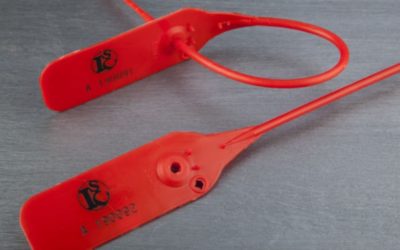Introduction
The purpose of security seals is to deter, prevent and identify unauthorised access, theft or a security breach in a business’s supply chain. Through visual & physical verification, security seals will help to identify the point of liability in the event of loss, damage and theft.
High Security Barrier Seal
A bolt barrier seal or ‘bottle seal’ given its ‘bottle-like’ shape, consists of a 2 part, strengthened metal bolt shaft which fits into its corresponding locking body. This type of seal is commonly used to secure vehicle doors and container doors. This seal needs to be removed by cutting with a bolt cutter, grinder or oxyacetylene torch.
A better understanding of ISO PAS 177712 & C-TPAT
“C-TPAT” (Customs Trade Partnership against terrorism) concerns all incoming containers to the USA. ALL containers must be sealed with a security seal that is classified as a high security seal. In order for a seal to be classified as a high security seal, the product must be tested by an authorised, accredited laboratory. One of the best known ones is DAYTON BROWN in NY. The seal goes through rigorous testing, tensile strength, bending, to name but a few. Without this certificate, the seal is not of the spec to enter the US/ Mexico or Canada. Only ISO PAS 17712 HSS can be used to support the requirements of the C-TPAT programme. (C-TPAT is a anti-terrorist programme, not a standard as such, so no certificate is issued to state this).
Plastic indicative seals
These seals are typically adjustable, pull-through seals or fixed length seals. Depending on the plastic type and strength of the seal, these can commonly be broken by hand.
The inherent weakness of a pull-through seal (with notched or smooth strap), is that it can be sealed and if not pulled through all the way can be cut or broken in the loop and re-sealed. The user has to ensure that the seals are correctly applied and inspected in detail before authorised removal is attempted.
Plastic indicative seals are generally constructed from oil based plastics, PP (polypropylene) / PA (polyamide) which resist attempts at gluing. Many of ICS’ products contain an insert in the locking chamber, of a hardened plastic, thereby increasing tamper resistance. For increased security, a metal insert is available in the locking chamber for certain options.
Plastic seals have diverse application: bags, containers, doors, gates, baggage, drums, diesel caps, cages, metering & gaming equipment, emergency equipment, valves etc.
High security cable seals
The flexibility and strength of the cable makes this a popular product type. This type of seal cannot be removed by hand.
The non pre-formed, high-tensile aircraft cable cannot be cut by scissors and will require removal by a high quality side cutter. Once cut, the cable will fray and cannot be glued together again.
These seals commonly have a high pull strength and would typically be used on high risk applications like trucks, cages, containers, gates, drums, tankers and bags. Although a premium solution for many applications and therefore popular, consider the practicality of tool removal in a given environment.
Metal indicative seals
Metal indicative seals are perceived to be stronger and more secure than plastic, simply because their material construction is stronger and they offer a higher resistance to breakage or removal.
What must be taken into consideration is the ease of removal by authorised personnel. Metal may be strong making removal more difficult. The disadvantage of metal seals is that colour codification is not possible. Metal seals are commonly used on trucks, containers, gates & doors and on cash in transit canisters.
Combination material seals
These are seals constructed of plastic and a wire component, typically a stainless steel wire tail.
Combination seals are commonly manufactured from Polycarbonate for durability and longevity and are most prevalent in the utilities sector because seals are often exposed to harsh climatic conditions and are expected to be functional for long periods of time.
Colour & temperature stability and high impact strength are properties of this type of seal. This makes them a worthy choice for internally located applications like slot machines, where the heat generation can be quite high.



